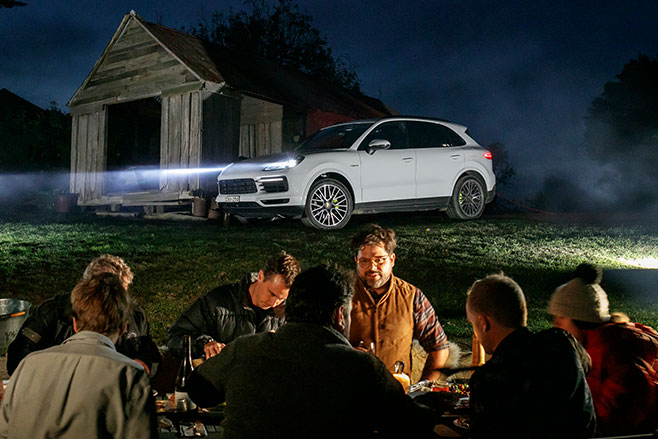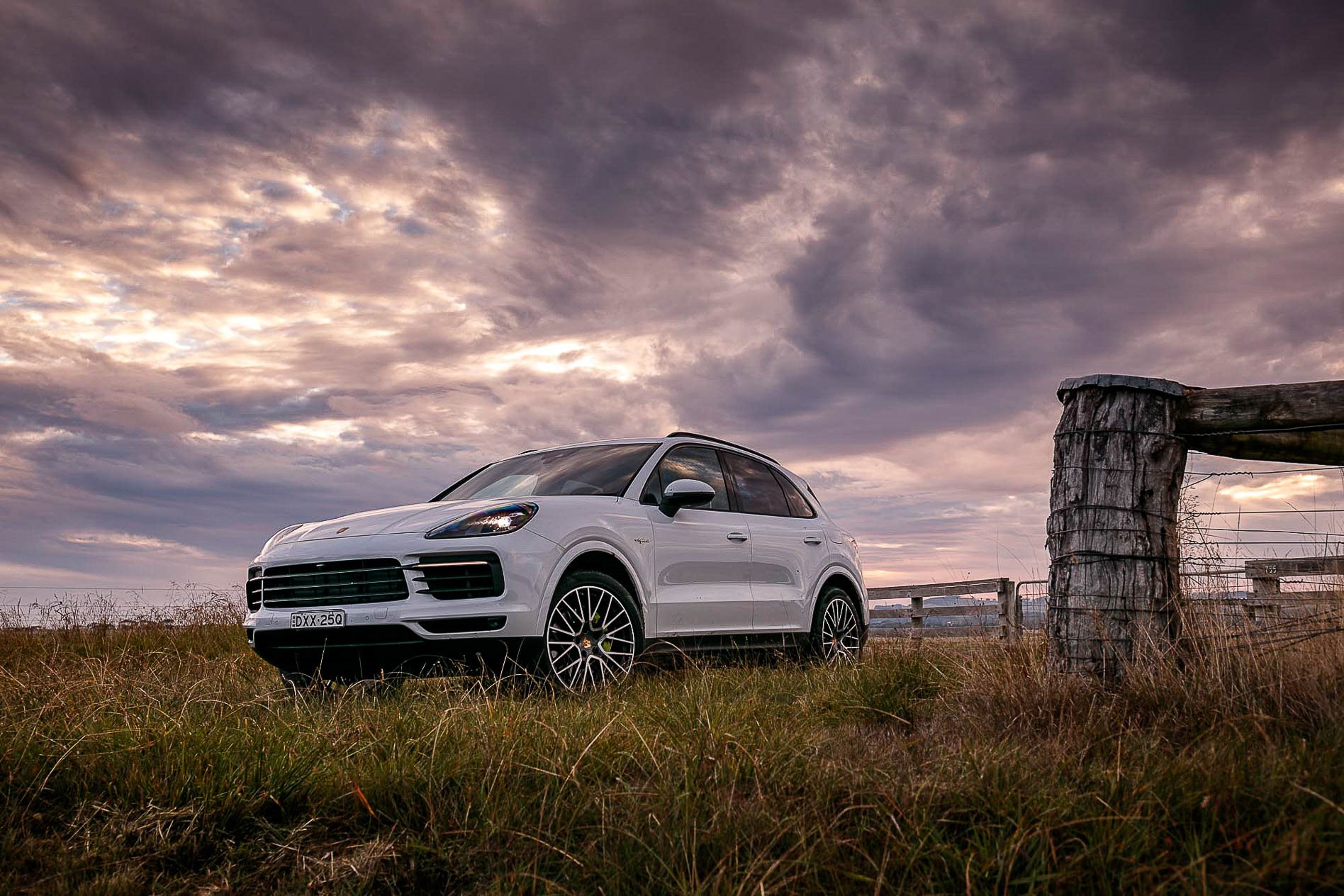
Nothing in the modern automotive world should come as a surprise any more.
Today, Toyota sells more Hiluxs to Australians than all of Holden’s models put together, the Pikes Peak hill climb record is held by an electric Volkswagen, Mitsubishi Australia still sells 300 examples of the 12-year old Lancer per month and, if current trends continue, the manual gearbox is likely to die out before the Lancer. Whatever next?
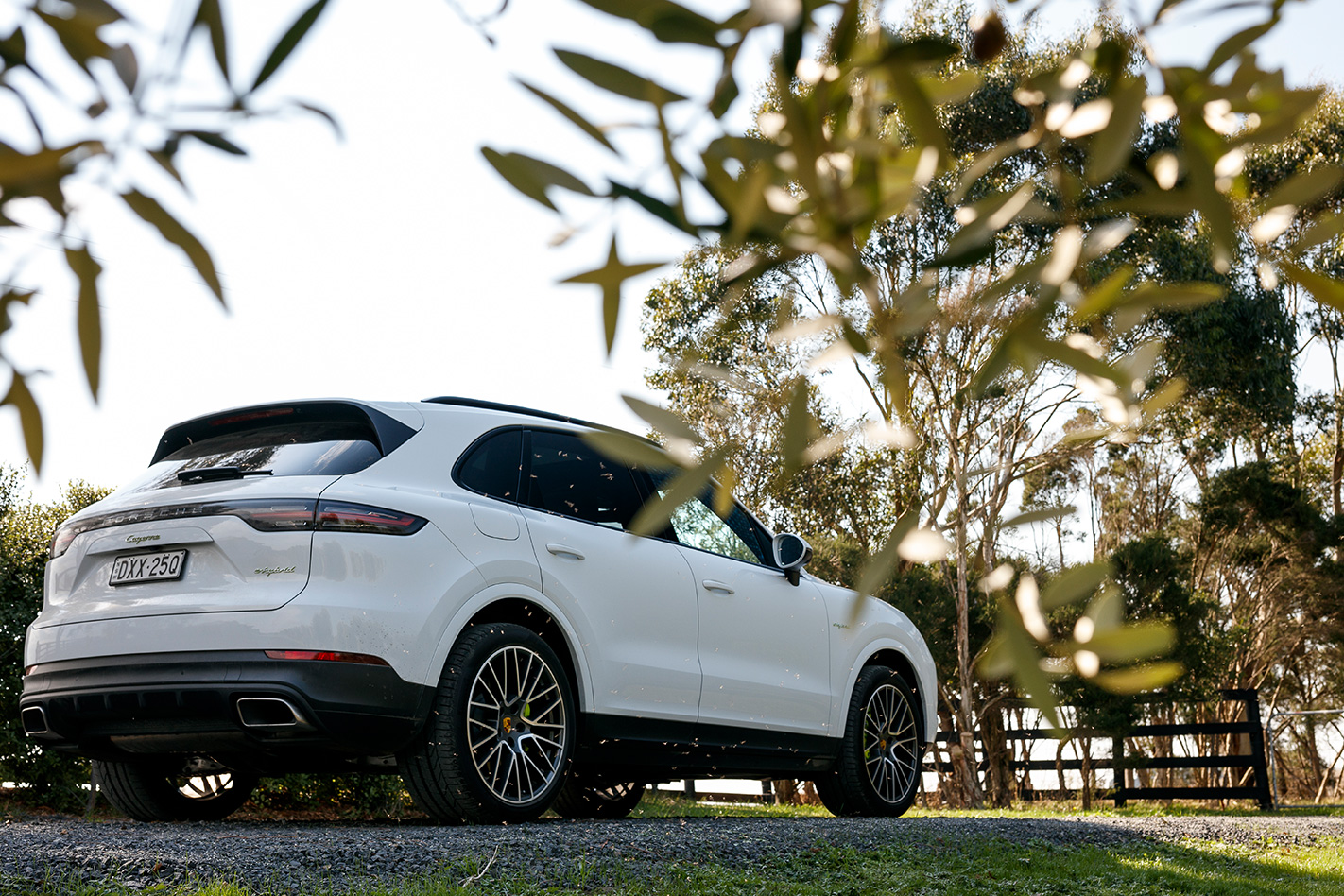
Over its 88 years, Porsche certainly hasn’t fought against the tides of change and virtually epitomises the ‘diversify or die’ mantra, landmarked in more recent years by the switch to a water-cooled 911, the introduction of SUVs and, perhaps most significantly, electrification.
In each case and many others, the German car maker has faced initial widespread criticism for technological and brand direction changes, only for the naysayers to return with tails firmly between the legs and glittering reviews.
That’s why we are so excited to snatch the keys to a Cayenne E-hybrid for the next six weeks.

For starters, the Cayenne in ‘standard’ combustion-only form (of which there are three variants) is a resoundingly impressive large SUV, with sublime handling characteristics, classy cabins and sharp styling, and its defining feature promises to impress as well.
While we’ll be keeping an eye on all those already established qualities, our main focus will be on the unique drivetrain.
In isolation, a hybrid-powered Porsche is intriguing in both a technological and historical context but, as it effectively takes the place of the now-discontinued diesel, there is a third element under the spotlight for the Cayenne E-Hybrid and another burden for it to bear.

In simple terms, the hybrid version uses the entry-level Cayenne as it basis including its 3.0-litre turbocharged V6 petrol engine, eight-speed automatic transmission and four-wheel drive system.
However, to that commendable platform, the E-Hybrid adds a 100kW electric motor slotted between the engine and gearbox, a 14.1kWh lithium-ion battery in the boot and a charging socket.
That’s right – the E-Hybrid is a plug-in, which means, given the correct circumstances, owners have the potential to kick their fossil fuel habit.
But Porsche is adamant to shake the perception that hybrids are just about efficiency, economy, saving fuel, saving the world, and saving face. While there certainly is a borderline altruistic motive to the E-Hybrid system, the company is highlighting its ability to boost performance too.
The manic 918 Spyder supercar and Panamera Turbo S E-Hybrid hyper sedan have unequivocally started a trend of ballistic plug-in Porsches, but now it is the turn of a large SUV to continue the bloodline and all that it represents. That, perhaps, is a harder stunt to pull off.
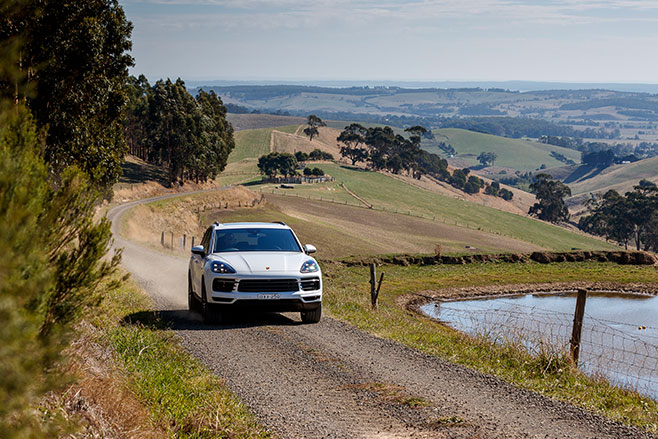
Its vital statistics appear to be impossibly opposed. On the one hand, the electric drivetrain adds a massive 300kg to the unladen weight of the entry-level Cayenne as well as $20,000 to its price.
But the benefits are equally spectacular on paper. Combined cycle fuel use is officially claimed to be 3.4 litres per 100km, and combined petrol /electric power peaks at 340kW and 700Nm of torque – enough to accelerate from zero to 100km/h in five seconds flat.
The Cayenne has a lot to prove. Following in the tyre tracks of its three excellent combustion-powered stablemates, the E-hybrid has to be uncompromising. It has to appease former diesel customers with prodigious torque and fuel economy, but it also has to convince a largely sceptical audience that plug-in power can honour the esteemed Stuttgart badge.
Most subjectively though, its heftier price of $136,700 has to offer irresistible value in the eyes of the customer and in the shadow of an increasing number of rivals competing in the electrified large SUV arena.
Investigating all of those compelling claims is what the next six weeks are going to be all about.
UPDATE 1 – Kicking the petrol habit
Let’s get straight to the heart of the matter and the Cayenne E-Hybrid’s defining feature – its electrified powertrain.
With an on-board battery that can be charged at home, the E-Hybrid offers a limited range of completely emissions-free driving, but I want to find out just how limited that range really is.
Forty-four kilometres is the official max, but Porsche says optional wheels can dent that figure. Oh… did I mention mine is shod with a gorgeous set of 21-inch RS rims wrapped in Pirelli P Zero rubber?
And, as my daily commute is a 38-kilometre round trip, those sexy hoops could be the difference between shaking loose the fossil fuel shackles or a working week that’s hooked on petrol for power.
Unlike some other plug-ins, the Cayenne defaults to pure electric power provided it has some juice in its battery pack, which encourages pure EV use over combined fossil and electron power from the turn of the key.
And, also unlike some others, the Porsche’s pure EV performance is not lacklustre. 100kW is not much for a 2.3-tonne SUV but its torque – 400Nm – is prodigious. In stop-start traffic, the petrol engine is rarely missed.
Even when at speed there is a smug satisfaction to gliding along with petrol-free power, and the motor will send the big Porsche well beyond the national speed limit before needing to call on its V6 for help.
But you do start to pay the price of aerodynamic and tyre drag, and my challenge is first unravelled by a desire to go quickly.
It’s the same for acceleration, as well. Hammer the throttle off the lights and the predicted range drops off a cliff. Regenerative braking helps to recapture some energy that would have been lost as heat energy in cars with conventional brakes – herein lays another good Porsche trait.

While not completely absent, the spongy pedal associated with some PHEVs is nowhere near as evident in the Cayenne, and there is a reassuring firmness before the travel pushes through to actual caliper and disc intervention.
It becomes clear early just how driving style effects vehicle efficiency, and I’m amazed how much more I concentrate on being a more efficient driver when it was battery power in question, not petrol. It’s ironic, since measure for measure electricity pumped in at home is roughly half the cost of petrol at the servo to cover the same distance. Surely I would be driving more wastefully with that knowledge?
The E-Hybrid’s technology extends to the information system allowing careful monitoring of energy reserves or journey planning. A kilowatt/hour consumption gauge is the modern equivalent of a kilometres per 100km economy figure, and allows real-time monitoring of my driving style and serves as a useful educational tool. The system will even reserve some battery power for better use later in the journey if you enter a navigation destination.
In the endless pursuit to make the Cayenne go further on a single charge, I find myself bordering on the obsessive. On more than one occasion I avoid using the air conditioning (which is electrically driven) or opening the window at higher speed, which might compromise aerodynamics and range.
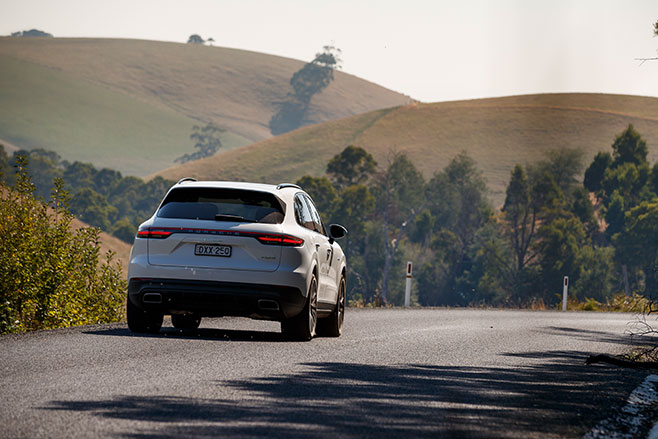
With a little practice, though, and a few failed attempts, I arrive at work with exactly half a battery charge remaining and succeed in returning home again using the other half. Confident that the performance was repeatable, I set about completing an entire week in the same manner and … I succeed!
The real beauty of a plug-in hybrid is that you don’t have to be as glued to the battery meter or any of the other clever E-Hybrid system information. If you get enthusiastic with the accelerator, the V6 is there to take you further.
My case is a tricky (if not impossible) one, living as I do right on the edge of the Porsche’s electric-only capacity, but according to the Bureau of Statistics, the average Australian travels 16 kilometres to get to work.
For a majority of commuters, then, the Porsche’s pure EV range is more than adequate and would not require my bloody-minded determination to succeed. That said, living with an EV is something every driver should do for a short time at least.
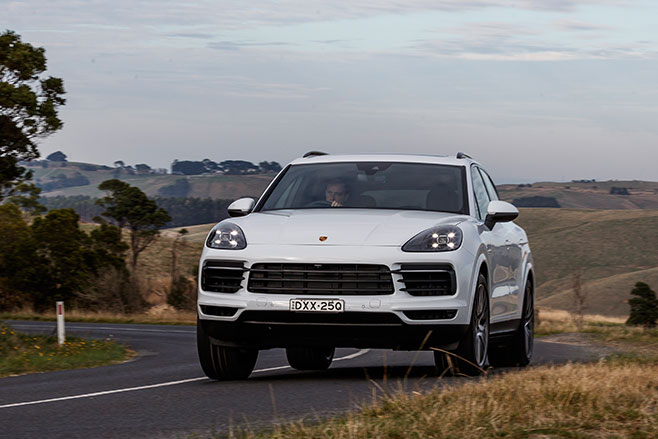
It’s amazing just how much this challenge has reshaped me as a driver. Without the option to simply pull over and replenish the battery in minutes as per a petrol station, I became hell-bent on conservation.
And my behavioural changes highlight that, for pure electric power to tip the balance, its convenience is probably a greater priority for many Australians than any potential financial savings.
As electric cars become more affordable, charging technology accelerates and infrastructure grows, the reality of going electric will become both cheaper AND more convenient.
You know what’s more surprising than the feasibility of an EV commute, even in my circumstances? Not only has living with a limited-range EV made me a better electric car driver, it has made me a more considerate, smoother and more efficient driver in every vehicle. I never expected that from the big Porsche.
UPDATE 2 – Leaving the city lights
During my first days with the plug-in Porsche Cayenne, it seemed logical to focus first on its hybrid drivetrain and urban commuting – the environment that the electric side most lends itself to. But now it has irrefutably demonstrated that it is possible to shirk petrol power for five days out of seven, it’s time to turn my attention to the remaining two.
When the weekend swings around, many owners of large SUVs like to load up the family, leave the city lights behind them and hit the road out of town.
It might wear a badge more traditionally associated with visceral high-performance coupes and convertibles, but the Cayenne is still a large SUV with four-wheel drive and room for five aboard. On face value, therefore, this big plug-in also promises to do the job of any other high-riding family wagon, but does it?
Step one in this slightly staged practicality test looks at the simple and easily quantifiable challenge of fitting everything in. Unlike the three other variants in the Cayenne range, the E-Hybrid’s boot floor has been raised to accommodate a pack of lithium-ion cells at a cost of 125 litres.
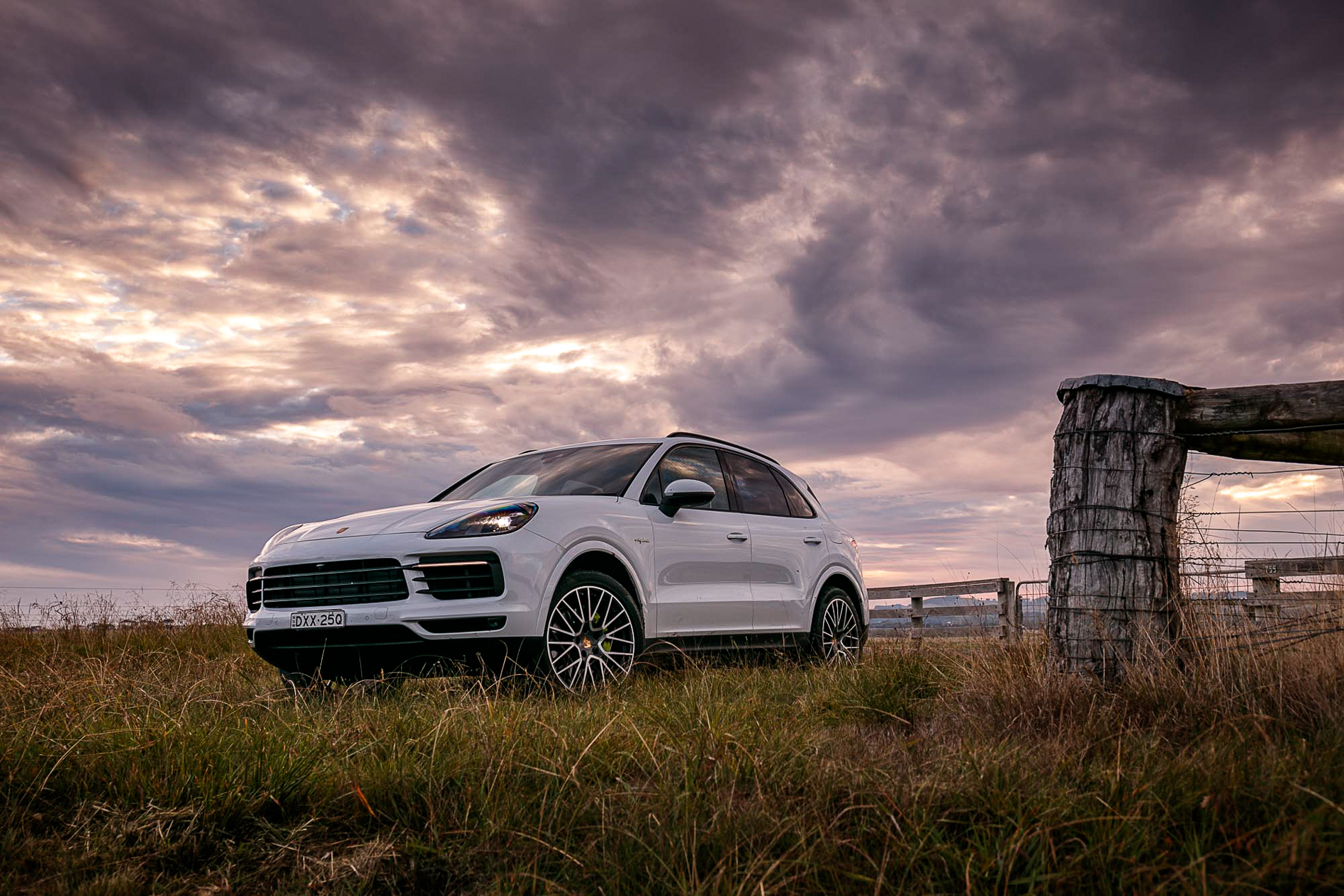
By way of example, an early trip to Ikea was not disappointing, swallowing an entire outdoor couch setting in flat-pack as well as its cushions – which categorically do not flat-pack. Filling the boot with typical camping items including a large Esky, a swag and camping chair was as simple as the furniture.
There are other large SUVs out there for less cash that perform the duty of packhorse more convincingly, of course, but while an extra 100+ litres of space would never be unwelcome, the E-Hybrid is accommodating for both things and people behind the front row of seating.
But, while the big Porsche gets a pass for the cargo test, its other rural-focused features would earn it a gold star.
Unexpectedly, the cruise out of town was performed with the panache I had grown to expect from the Cayenne range. Each variant has exemplary road manners whether you’re gliding along freeways or carving more interesting byways.
Other than a brief blast over a dusty track in Crete during the model’s international launch, I’d not yet have the opportunity to test the Cayenne’s all-terrain ability. Now’s the time.
Turning off the sealed surface somewhere between the Black Spur and the wilds beyond, I had a first opportunity to engage the ‘Offroad’ setting in the various driving modes. Unlike Auto, Sport and Sport Plus, you won’t find this mode in the 911, Cayman, Boxster or Panamera.
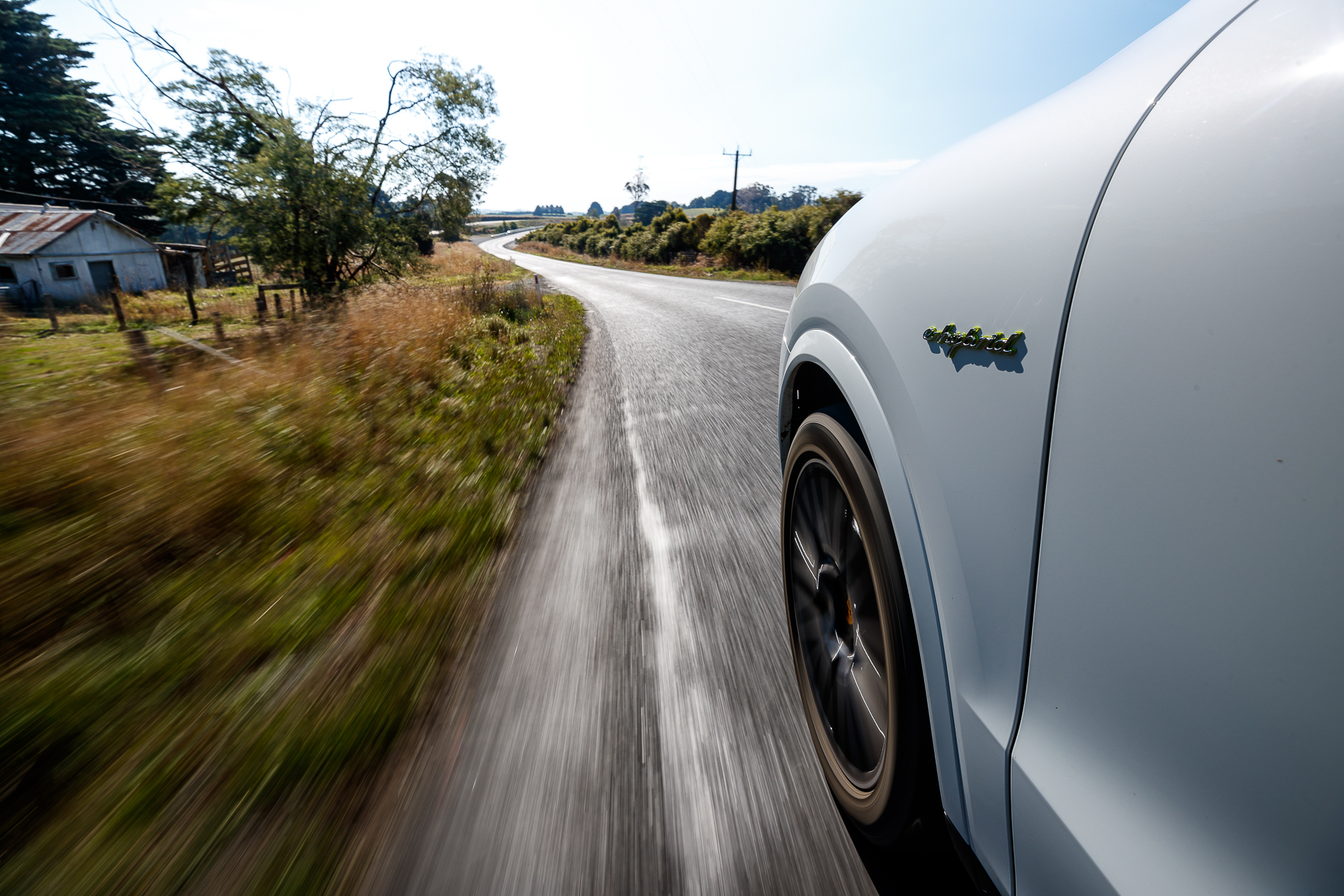
With the adaptive suspension jacked up to its maximum height to allow boosted ground clearance, the Cayenne is now poised to go places you cant in most other Porsches.
It’s about this point we should acknowledge the elephant in the room and the likelihood of a Cayenne (of any variant, model or vintage) ever tackling off-road work more challenging than a damp boat ramp.
The paradox is not limited to Porsche’s ranks, though, with many SUVs of all manufacturers unlikely to see realistic all-terrain duty during their useful lives, but that doesn’t mean any pertained ability should not be explored.
It’s a decision I started to regret as soon as the way ahead turned unexpectedly steep and as slippery as ice.
Initial inspection suggested the surface was relatively friendly sandy dirt but after an evening of torrential rain, it was obvious that the trail comprised solely of the clay that this area is widely known for. Since the point of no-return had long since passed, I pressed on.
Instead of sliding helplessly at very low speed into a ditch and spending the rest of the day climbing hills looking for phone reception and explaining to the car’s keeper why it was on its side, the Cayenne tackled the adverse conditions with unbelievable stoicism.
My car had been fitted with optional 21-inch RS wheels wrapped in Pirelli P Zero tyres – for those like me who know little of the art of off-road driving, that’s just about the most unsuitable combination for anything other than going around asphalt-covered corners really fast.
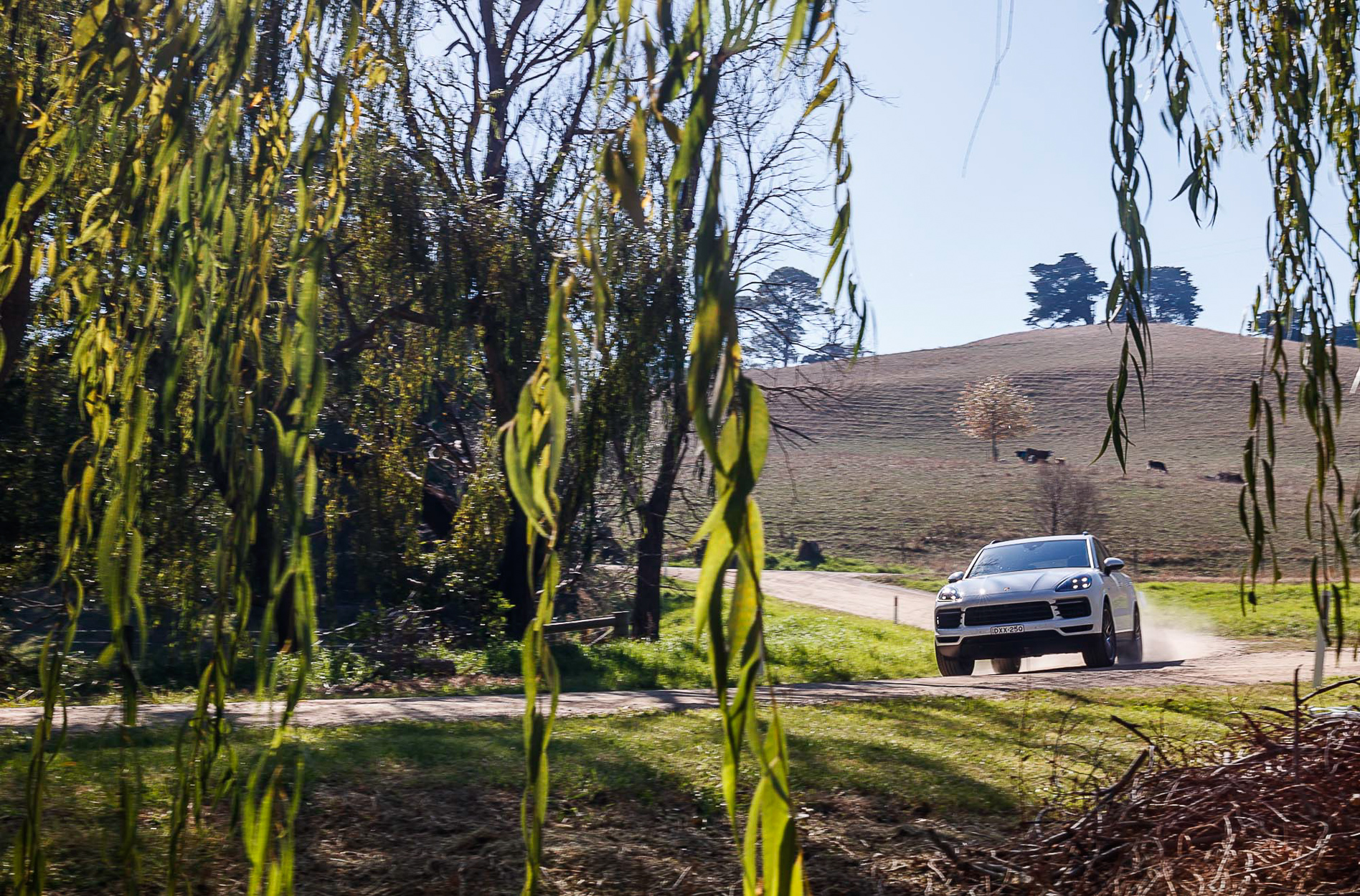
But even though the tread face of the tyre was almost immediately clogged solid with the thick yellow mud, the Cayenne’s sophisticated electronics and traction control system instantly and consistently made up the shortfall.
With both petrol and electric power providing the grunt – lots of grunt, in fact – the Cayenne simply worked it all out and found a way where you would swear blind there was none.
I hate to use cliches when describing any car for fear of sounding unimaginative, but the E-Hybrid was rapidly shaping up to be many cars in one. With such decent on-road capability, I would have bet cash that it would have compromised its all-terrain nous. Instead, it has been one of the most surprising aspects of its many virtues yet.
I could have camped out with my meagre rations and basic swag, cosy in the knowledge that the Cayenne (despite road tyres and a hearty weight penalty over combustion-only variants) would get me out of situations far more adventurous than its pilot. But with more rain predicted for the evening and the prospect of a blast back over the Black Spur as an alternative, I took the decision to break camp and split.
As is so often the case with SUVs, the promise of far-flung adventures, wading creeks, climbing rocky outcrops and summiting dunes often remains a good intention rather than a reality. At least in the E-Hybrid’s case, you can rest assured that its all-terrain credentials surprisingly exceed many expectations – including mine.
UPDATE 3 – My favourite roads
In the weeks since I took delivery of the Cayenne I have established that it can masquerade as a pure EV for the weekly commute, perform the duties of a suburban SUV, but then put on a set of RM Williams and hit the road less travelled for weekends away.
That’s a few good strings to its bow already, but it’s a Porsche, and that means the Cayenne’s latest challenge focuses on the facets most frequently associated with the German brand – driving enjoyment.
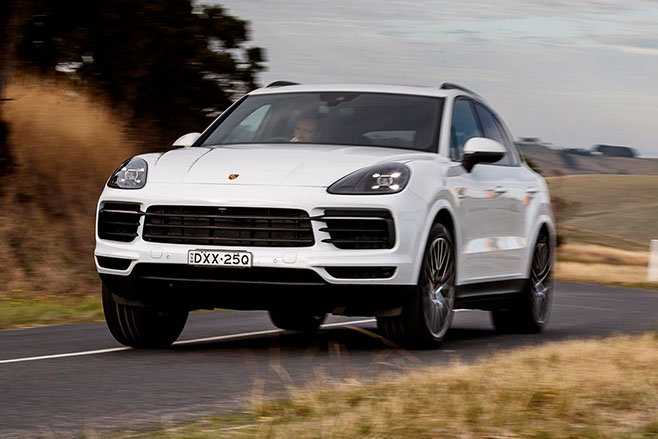
Not far out of Melbourne, there is a little-known ribbon of relatively quiet asphalt that I have been using to stretch the legs all manner of vehicles that claim to (often among other claims) provide a respectable set of driver-focused attributes.
Over the years, I’ve left a lot of rubber behind, and taken a lot of memorable impressions too, from HSVs to Lamborghinis over this excellent series of corners and widely differing road surfaces. Now it’s the turn of the Cayenne E-Hybrid.
Least surprising perhaps is that the E-Hybrid is fast. With 700Nm of torque on tap and a generous 340kW, it applies the muscle-car principle: lots of grunt to overcome lots of weight. With all its electrified bits, the plug-in version weighs a monstrous 300kg more than the entry-level Cayenne on which it’s based, but instant torque and the combined output appears to defy physics to a degree.
Electric torque and permanent four-wheel drive gets the big Porsche off the mark with a satisfying eagerness and, when in the higher gears, that instantaneous reaction continues to surge the E-Hybrid ahead. Switching to Sport or Sport Plus makes a big difference with any remaining battery power recruited for maximum acceleration enhancement, while range maximisation is put on the backburner.
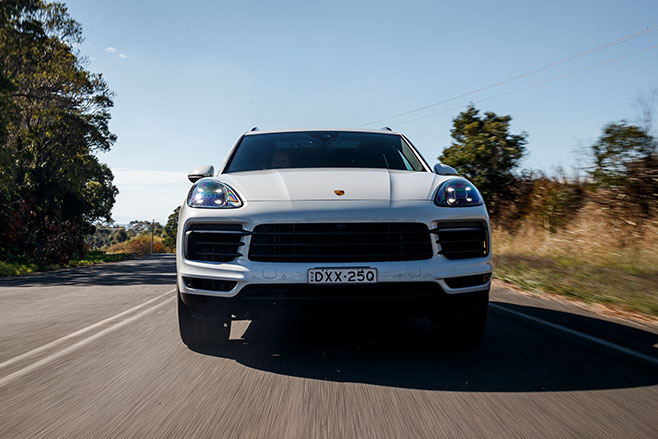
The official zero to 100km/h time is 5.0 seconds, but it feels quicker thanks to the omnipresent torque and the two different motors working in unison conspire to plug any holes in the torque curve. The result is a feeling of boundless and unending power delivery.
With all eyes on its electric motor partnership (and a 2.9-litre twin-turbo V6 higher up in the Cayenne range), the 3.0-litre V6 single turbo under the E-Hybrid’s bonnet doesn’t get the attention it deserves. It’s a real sweetie.
At low revs there is a comforting and succulent note from the standard exhaust which rises to a classic V6 bark nearer the red line accompanied by linear power delivery all the way through to its free-revving maximum. I’d love to sample the optional sport exhaust that is now available for the E-Hybrid for the first time.
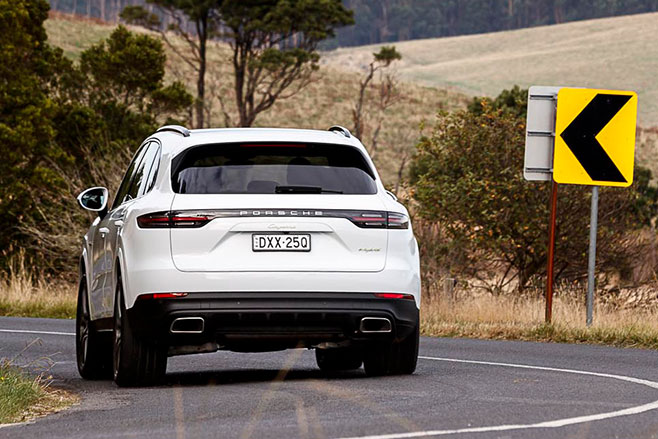
Snatch a different gear using the steering wheel paddles and the eight-speed automatic delivers another cog with dual-clutch urgency but the smoothness of a torque converter. When left to its own devices, the programming is intuitive at the aggressive end of the spectrum, but switch out of Sport and it’s calming and benign.
For the third-generation Cayenne, Porsche took the model’s chassis into new territory and all three petrol-only variants (Cayenne, Cayenne S and Cayenne Turbo) are a delight on the road with defiantly flat body control through fast bends, massive lateral grip and plenty of positive steering feel.
But the hybridised version carries a significant weight penalty, and there’s no hiding it when the way ahead turns twisty with more tendency to lean onto its outside front corner. While the other variants can carry more speed into corners, the hybrid requires more management prior to bends and will punish mid-corner braking and too much entry speed.
Even with its extra electric payload though, the E-Hybrid is still surprisingly agile when changing direction. Light steering is precise, and the all-new platform has clearly been engineered with the heaviest end of the range in mind – not as an afterthought. It can’t keep up with the lighter siblings, but it still represents the upper end of handling when compared with rivals from other brands.
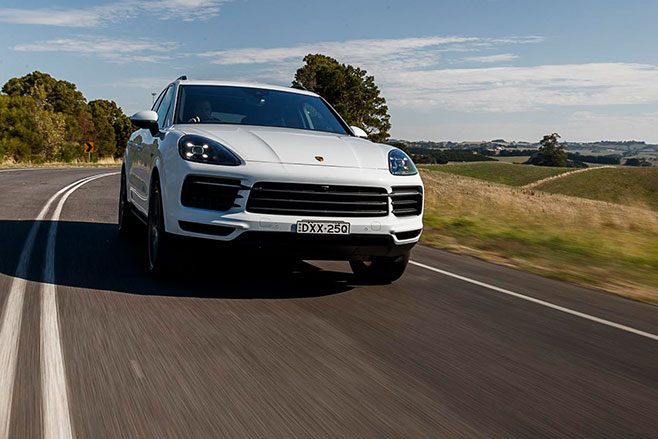
Hard braking also throws a few surprises into the mix. Initial pedal travel is disappointingly gluggy with the softness associated with hybrids that use lighter braking to recharge the battery. Push harder though, and the mighty ten-piston calipers come into play with a redeeming firmness that is a trademark of the Porsche middle (left) pedal.
It is possible to fill both of the front rotors with too much heat, but you’re unlikely to get the opportunity to do that away from the track.
Most commendable though, is the intuitive final drive’s attitude. Regardless of the drive mode, the adaptive transmission favours the rear wheels until the front axle is required and that adds an immediately noticeable sporty intent.
Wider rear tyres compared with the front hoops (a standard feature regardless of the variant or option) add to the driver-focused chassis and overall layout.
It would be easy to dismiss the E-Hybrid as the Cayenne that sacrifices a slice of the Porsche mission statement in favour of emerging technology, but that’s simply not fair or correct.
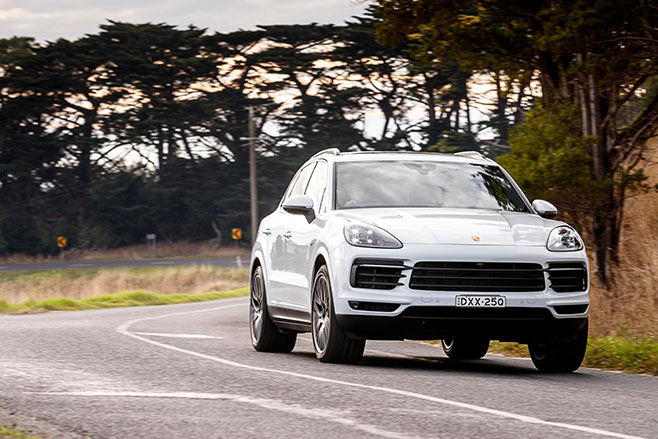
A shamelessly hard drive through familiar roads has revealed exactly the opposite. Not only is my favourite element of the hybrid system the way that it makes the Cayenne go, but it’s clear that Porsche would not have jumped into the alternative energy arena unless the time was right.
The Cayenne E-Hybrid is not an empty gesture of good intent, it’s proof that the technology that is good enough for hypercars and large luxury sedans is also potent and practical enough to apply to its large SUV as well.
Update 4 – The charge challenge
With up to 44km of electric-only range, the E-Hybrid has conclusively proven that it can behave as a pure electric vehicle for a majority of commuters including me. As long as you have a dependable charging source at home and, even better, at work, the Cayenne’s six cylinders can conceivably stay dormant from Monday to Friday. But not every journey is so formulaic or predictable.
If the Cayenne has to deviate and go further than the daily grind, it has a petrol tank and a 3.0-litre engine to keep you going much, much further and that is, as I have found, what makes it so versatile.
But wouldn’t it be nice if you only had to resort to combustion power for the longest journeys far away from civilisation? Surely with a growing network of public charging points, it’s possible to rely on battery power for more than the prescribed 44km.
In my final test of the E-Hybrid’s versatility, I decided to go about an average day’s duties with the intention of only using electric power.
With a little planning I would be able to visit a shopping centre, Melbourne’s CBD and the gym, each time parking the Porsche at designated fast charge spaces to keep me rolling without petrol power.
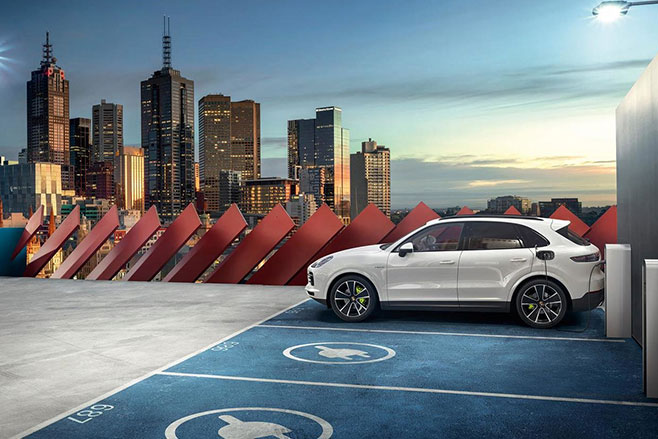
Before I embark though, there is a little preparation that will increase my chances of succeeding. A good start for any PHEV or EV owner is to have the relevant smartphone applications ready to go. PlugShare, Chargemap and Greenlots are three popular options with a global focus and help pinpoint charging locations with additional information depending on the application.
Australia has about 800 charging points around the country but more than a quarter of those are not special fast chargers. If you’re planning a trip, it’s essential to know how long your car will need to stay at each charger for a top up.
Armed with that information you will be off to a good start but, as this fourth test highlights, there are still plenty of pitfalls.
My first stop of the day is at a major shopping centre the likes of which you will find all over Australia’s capitals and many in between. According to my intel, the mall offers multiple charging parking spaces, but it’s here that I learned that it’s wise to check the details more closely.

There’s no chance of altruistic charge point sharing when it comes to Tesla. The Californian EV maker made an early decision to allow only its vehicles to use its network of so-called Superchargers and so all spaces at the centre are off limits as they are to every brand of EV and plug-in that isn’t a Tesla.
I can’t help but feel this is a decision that may come back to bite Tesla at a point in the future as all other EV and PHEV manufacturers adopt a more strength-in-numbers approach, but time will tell.
For my next stop, an errand in Melbourne’s CBD appears to open up far more options as the charger density increases towards the city centre. However, I’ve learnt my lesson and a cursory check of the options immediately rules out many.
Hotels won’t let you plug in without a reservation, and other charge points turn out to be dealerships with topping up only for service customers.
However, I have used one public location numerous times before so I plot a heading to Federation Square. During the week, the parking charges are astronomical but being able to top up the battery is at least worth it in a plug-in. On arrival though, I realise the pair of parking spaces have been temporarily cordoned off to allow for a tourist attraction.
For now, The Winter Village has commandeered power for EVs to freeze water into an artificial ice rink – While global temperatures warm up, an EV charging station has been repurposed to cool Melbourne down. Hmm.
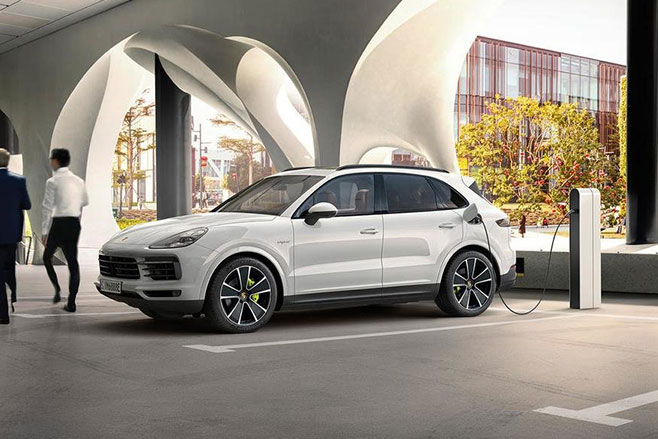
Given time, there are plenty of other EV charge points about the city and a glance at my phone would highlight the next best position, but time was tight so it’s off to the next location.
My final task took me via the gym, where, like increasing numbers of community centres, the local council has funded the installation of EV charging infrastructure. The only problem is that there are still numerous different types of vehicle charge sockets. Arrive at the wrong plug and it may as well not be there at all.
In Australia, Type 2, Type 3, J-1772 and Tesla plugs are the most common in use and the Porsche has a Type 2, if you were wondering. Many applications will detail what kind of charge plug awaits at each location and the advice is, once again, to read the footnotes before you set out.
Okay, full disclosure: At this point I feel it is fair to point out that in the video above I might have applied a little artistic licence to hammer home the point, but that’s not entirely fair to the leisure centre we stopped at.
Actually, the location was the Oak Park Sports and Aquatic Centre which has one of the best charging locations we encountered with three spaces offering a wide range of fast charging options. Credit to the Moreland City Council for getting behind the cause.
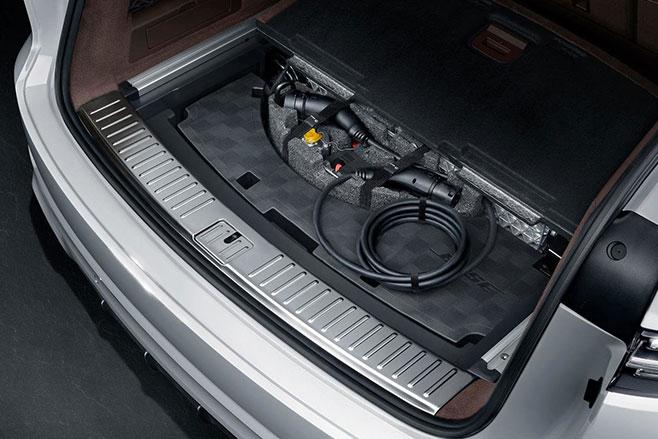
Unfortunately, I have all too often been confronted with a promising looking charge station with the wrong plug. But that is the reassuring feature about any plug-in. If you are faced with EV adversity, you can simply switch to petrol power.
This test was a fail but not because of any particular Cayenne shortcomings. In fact, the red pen was applied not to the Porsche but to Australia’s attitude to EV support, and the plug-in principle is allowing the EV cause to gain traction despite the lacklustre infrastructure.
As the popularity of EVs inevitably gains momentum though, the network of charging stations will grow correspondingly and it won’t be long before a day’s errands will be completed under electric power alone, with ease, and without having to plan the route in advance.
Until then, plug-in power including Porsche’s E-hybrid range is providing the very best of both worlds.
Update 5 – Farewell
And just like that, six weeks have flashed by. It seems like only yesterday that I was poring over the new arrival in my basement carpark, exploring all the Cayenne’s features and formulating ways to test them all out. But now it is time to hand back the keys and bid farewell to the E-Hybrid.
Much as I’ll be sad to see it go, I am also excited that I can finally sit down with a cup of tea and crunch the numbers – tearing around the country in a turbocharged Porsche is great fun but it’s nothing compared with a bit of maths.
At the start of this 40-day review, I set out to answer two key questions – Can a Porsche still be a Porsche when it has a hybrid powertrain wrapped up in an SUV body? And does a large plug-in high-rider make sense regardless of the badge?
In the process, not only did I answer both questions, I answered a third: Does the E-Hybrid adequately replace the now discontinued diesel? But first, those figures I was talking about.
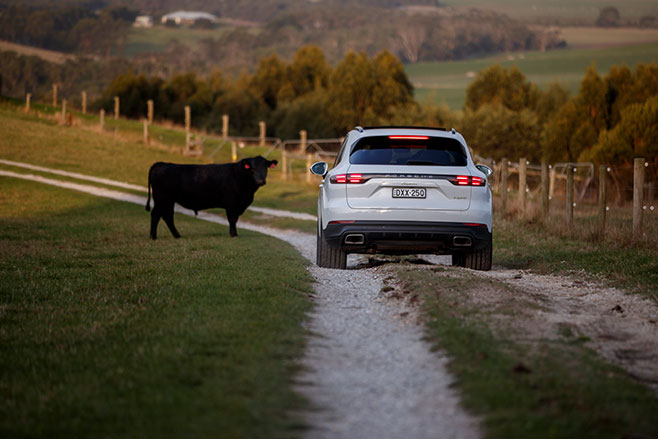
After a bit of practice and playing to the EV sensibilities, I could make the 14.1kWh battery last all the way to work and back again. In the process, I would use near as much every electron it could spare during my 38-kilometre commute but not one drop of petrol. Using a special gauge, I measured that to replenish the completely exhausted battery required 13.1kWh of energy and at an average rate of 27.6 cents per kWh, a full five days of charging cost $18.05 in power.
Compare that to the base Cayenne, that uses exactly the same 3.0-litre V6 engine as the E-Hybrid, minus the electrified bits and you have a fair petrol-powered equivalent. According to Porsche the Cayenne wants 11.3 litres of fuel per 100km when driving in urban conditions, which equates to 21.47 litres of fuel for my weekly commute. Let’s say 98 RON fuel is about $1.55 per litre, which means the petrol cost to get me to work and home again for the working week is $33.28.
Not only is it feasible to rely only on electric drive for a majority of commutes, in doing so you will almost halve your fuel bill – in that regard, the Porsche Cayenne E-Hybrid makes a lot of sense. But it does cost $20,000 more than the entry-level Cayenne so it will take you 25 years of commuting before it pays for itself.
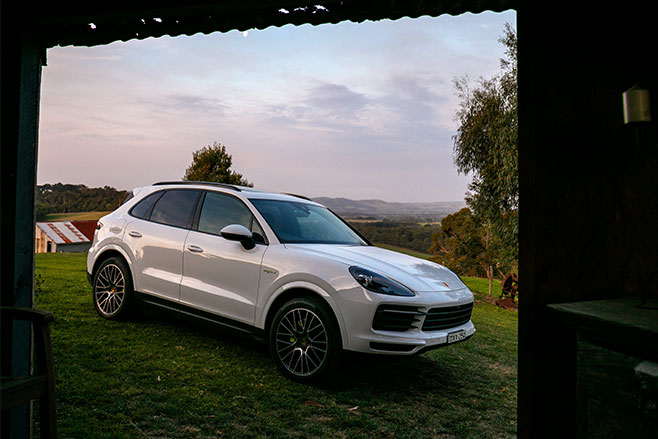
That’s not the point though. The Porsche is an aspirational car and if saving cash was your driving ambition then you wouldn’t be considering any model within the ranks of a high-end high-performance German brand. The Cayenne goes further than that.
Even when the engine did fire-up for longer trips away from the daily grind, the regenerative braking that captures energy that’s otherwise wasted in a conventional Cayenne enables the E-Hybrid to continue delivering impressive economy figures. Over the course of its six-week internship, it returned a final figure of 8.27 litres per 100km.
While that number might be a fair way off Porsche’s claimed combined figure of 3.4L/100km it must be pointed out that the car was being subjected to some serious work. You don’t lift an inside front wheel when doing cornering photography by driving economically, and no one ever said navigating thick clay trails after rain is the most efficient style of driving. During my time with the Porsche, I threw everything at it.
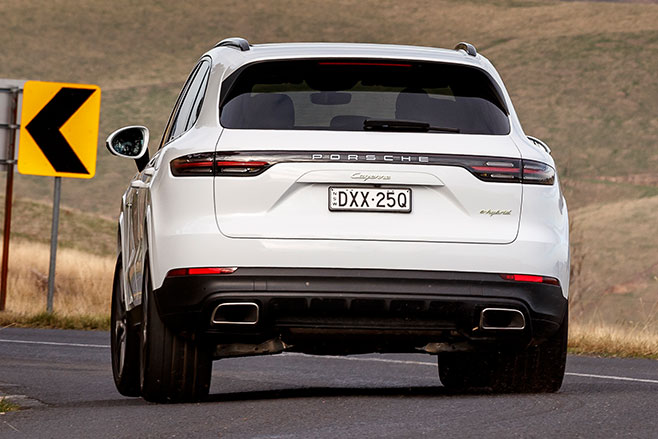
If you ignore the occasions when it was fulfilling photographic/feature duties and put to a more realistic working week it used less than 7.0L/100km.
For a 2.3-tonne SUV to return that consumption figure with me at the wheel is frankly astonishing.
Which leads nicely into the other part of the question – It might carry a decent weight penalty over the other variants in the range but the third-generation Cayenne platform was clearly designed to cope with this heaviest version, and its dynamics are surprisingly good.
There’s no hiding the extra bulk when you really chuck it about, but the E-Hybrid still manages to handle and hold the road with grace and it’s up there with the most rewarding large SUVs.
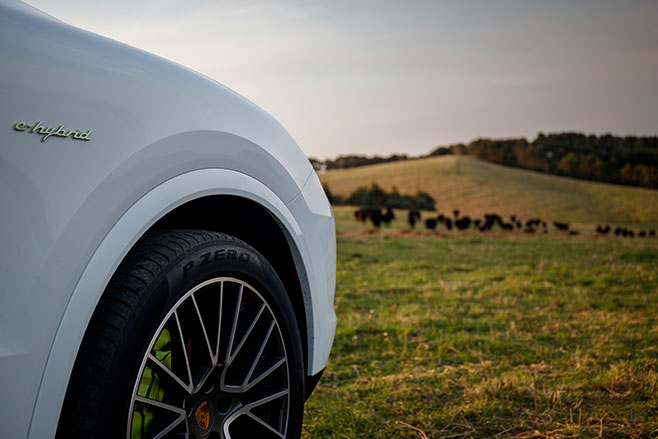
Finally though, the elephant in the room and the absence of a diesel option. In the second-generation, the Cayenne V6 diesel offered 193kW/580Nm, claimed fuel economy of 6.6L/100km and a zero to 100km/h dash of 7.2 seconds. After driving the E-Hybrid, it’s hard to imagine any diesel customer that would genuinely lament the passing of V6 diesel power.
Harder to forget however, is the Cayenne S Diesel variant. It brought a V8 diesel with twin turbos, an output of 283kW/850Nm and fuel efficiency of 8.0L/100km. Despite that herculean torque figure it still can’t match the E-Hybrid’s acceleration of 5.0s dead. There’s also the small matter of its $150,000 asking price versus the E-Hybrid which is cheaper to the tune of about $15,000.
After six weeks in the driver’s seat I can confidently say this:
The Cayenne E-Hybrid upholds the Porsche performance mantra admirably. It might not keep up with much in the rest of the Porsche model line-up, but that doesn’t stop it being seriously fast in a straight line and through twisty bits.
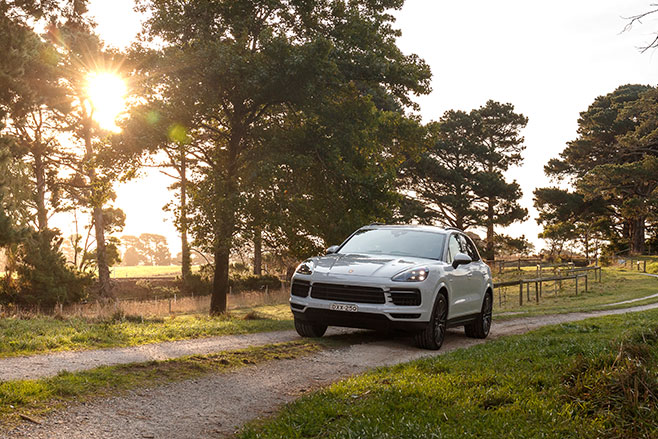
Plug-in power not only makes perfect sense in the large SUV category, as it effectively creates many cars in one model, but it is also perhaps most applicable at this end of the market.
And with a sophisticated and versatile powertrain that is both frugal and potent in the real world, it is easy to recommend the plug-in Cayenne as a successor to the diesel.
But more significantly than all of those findings, the Cayenne E-hybrid is proving that, with a more concerted effort in supporting infrastructure, pure electric power can and really does work with little or no compromise.
With Porsche’s first pure electric model glinting on the horizon, the future of high-performance electrified vehicles is looking very bright indeed.
